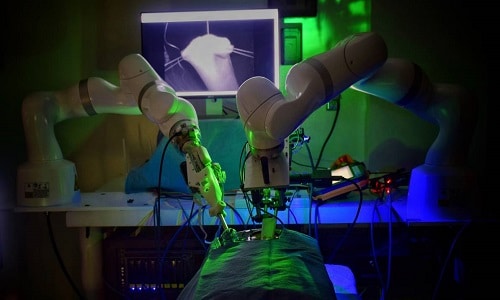Intelligent Robots Are The Future Of Surgery
Traditional operating rooms are evolving into precision hubs filled with innovation where augmented intelligence and real-time imaging technology are essential components in surgical care. This move toward robotics in healthcare is critical to the pursuit of surgical excellence that will enhance a surgeon’s skills as well as improve patient outcomes.
Using advanced technologies, surgeons are successfully overcoming the limitations of the human hand and eye. Augmented intelligence is building on a layer of decision-making support that complements a surgeon’s expertise, and real-time imaging is making sure that augmented reality is continually updated with vital information. These advances are setting the stage for a future where surgical intervention is reliable, complications are reduced, and recovery times are shortened. A new age of healthcare is upon us.
Big trends like this come to light each year at the Robotics Summit in Boston. The show helps the industry prepare for the next phase in robotics. At this year’s show, taking place May 1 and 2, healthcare robotics will be trending, and this time, with a focus on revolutionizing surgery.
Dustin Vaughan of Asensus Surgical will be leading a session, “Leveraging Real-Time Data Insights in the Operating Room,”weighing in on technology integration, surgical applications, data and privacy, and cost and accessibility. The Asensus next-generation digital surgery platform, LUNA, is designed to elevate the standards of robotic-assisted surgery. It incorporates advanced hardware and software, and features a surgeon console, interactive touchscreen, and Ultra-HD 3D monitor for enhanced visibility. With four robotic arms for various procedures and a unique instrument drive for a range of advanced tools, it’s a leading example of the industry’s cutting-edge developments.
The LUNA platform represents just a slice of the broader movement toward integrating sophisticated robotic systems into healthcare. As the Robotics Summit is sure to show, this shift is not just about augmenting the capabilities of surgeons but fundamentally transforming patient care.
Performance-Guided Surgery
Across the many Robotics Summit sessions devoted to healthcare robotics, there will be a recurring focus on performance-guided surgery (PGS), which has been a major advancement in robotic-assisted surgeries. The fundamental purpose of PSG is to provide real-time intelligence during surgeries and promote consistency.
At the core of this innovation is the Intelligent Surgical Unit (ISU) and the digital powerhouse of the Senhance Surgical System, the first augmented intelligence system to receive FDA approval for surgical use. The ISU enriches the surgical experience with its advanced features like haptic feedback, which provides surgeons the ability to “feel” the anatomy through the robot as if they were directly touching it, eye-tracking camera control that moves the camera based on the surgeon’s gaze, and 3D visualization for a comprehensive view of the surgical field. These tools are crucial for addressing the inherently variable nature of surgical procedures, aiming for consistently superior patient outcomes every time.
The ISU’s augmented intelligence capability enhances intraoperative procedures with 3D digital measurements of anatomical structures to millimeter precision, facilitating accurate straight-line and curved measurements. It also generates digital tags that act as both landmarks and educational tools, improving communication in the operating room and reducing the risk of accidental injuries.
The potential of PGS relies significantly on the seamless integration of robotics engineering and medicine. Achieving this ensures that existing technologies and hospital information stems work harmoniously with the new robotic platforms and do not disrupt surgical workflow. Even with this great potential, though, comes the question of accessibility.
Surgical Robots for All?
A focus on cost and accessibility has become a rising concern across the medical robotics industry. Healthcare providers want to offer these advanced medical services, but they must manage budget constraints. Many medical robotics companies are working to address these challenges by deploying several strategies such as modular design, leasing models, scaled-down models, and focusing on reduced operating times.
Leaders in this space, such as Vaughan, emphasize the greater good as an overall goal. Vaughan recognizes how the focus on “enabling clinicians to make surgery more predictable and accessible” speaks volumes about the industry’s direction. But to serve the greater good, these robotic systems need to be available to all. The challenges and solutions to making this a reality will also be discussed throughout the healthcare robotics sessions in Boston.
For Asensus Surgical, one of the most fundamental aspects of their vision involves making this revolutionary technology accessible. “Achieving genuinely aggressive cost targets… is absolutely a core requirement,” Vaughan explains. “Our internal engineering team and our manufacturing partner, Flex, have focused on developing a capable LUNA platform that is economically viable as we navigate the changing healthcare landscape. With the migration of some of our supported procedures into ambulatory surgical centers (ASCs), we realized early in the process that we have to achieve an aggressive cost target for individual surgical cases. This requires a holistic evaluation of a hospital’s workflow and their fully burdened cost of a robotic case.”
This emphasis on cost-effectiveness and accessibility could democratize robotic surgery, making it available to a wider range of healthcare facilities, including those with tighter budgets.
Conclusion
As we look toward the Robotics Summit and beyond, we see that technology and healthcare are at an exciting point. With many companies on this mission to make robotics and augmented intelligence a staple of the operating room, the future of surgery is about creating a more predictable, accessible, and secure healthcare landscape for everyone.
Author: Carolyn Mathas is a freelance writer/site editor for United Business Media’s EDN and EE Times, IHS 360, and AspenCore, as well as individual companies. Mathas was Director of Marketing for Securealink and Micrium, Inc., and provided public relations, marketing and writing services to Philips, Altera, Boulder Creek Engineering and Lucent Technologies. She holds an MBA from New York Institute of Technology and a BS in Marketing from University of Phoenix.



